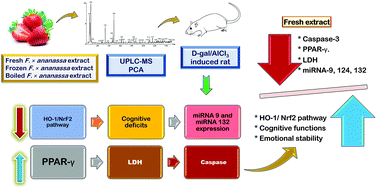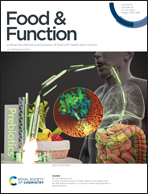Impact of different processing methods on the phenolics and neuroprotective activity of Fragaria ananassa Duch. extracts in a d-galactose and aluminum chloride-induced rat model of aging
Abstract
Age-related diseases, including dementia, are a major health concern affecting daily human life. Strawberry (Fragaria ananassa Duch.) is the most eaten fruit worldwide due to its exceptional aroma and flavor. However, it's rapid softening and decay limit its shelf-life. Freezing and boiling represent the well-known conservation methods to extend its shelf-life. Therefore, we aimed to discover the phytochemical content differences of fresh and processed strawberries associated with investigating and comparing their neuroprotective effects in a rat model of aging. Female Wistar rats were orally pretreated with fresh, boiled, and frozen F. ananassa methanolic extracts (250 mg kg−1) for 2 weeks, and then these extracts were concomitantly exposed to D-galactose [65 mg kg−1, subcutaneously (S/C)] and AlCl3 (200 mg kg−1, orally) for 6 weeks to develop aging-like symptoms. The results of UPLC/ESI-MS phytochemical profiling revealed 36 secondary metabolites, including phenolics, flavonoids, and their glycoside derivatives. Compared with boiled and frozen extracts, the fresh extract ameliorated the behavioral deficits including anxiety and cognitive dysfunction, upregulated brain HO-1 and Nrf2 levels, and markedly reduced caspase-3 and PPAR-γ levels. Moreover, LDH and miRNA-9, 124 and 132 protein expressions were reduced. The histological architecture of the brain hippocampus was restored and glial fibrillary acidic protein (GFAP) immunoexpression was downregulated. In conclusion, the fresh extract has neuroprotective activity that could have a promising role in ameliorating age-related neurodegeneration.



 Please wait while we load your content...
Please wait while we load your content...